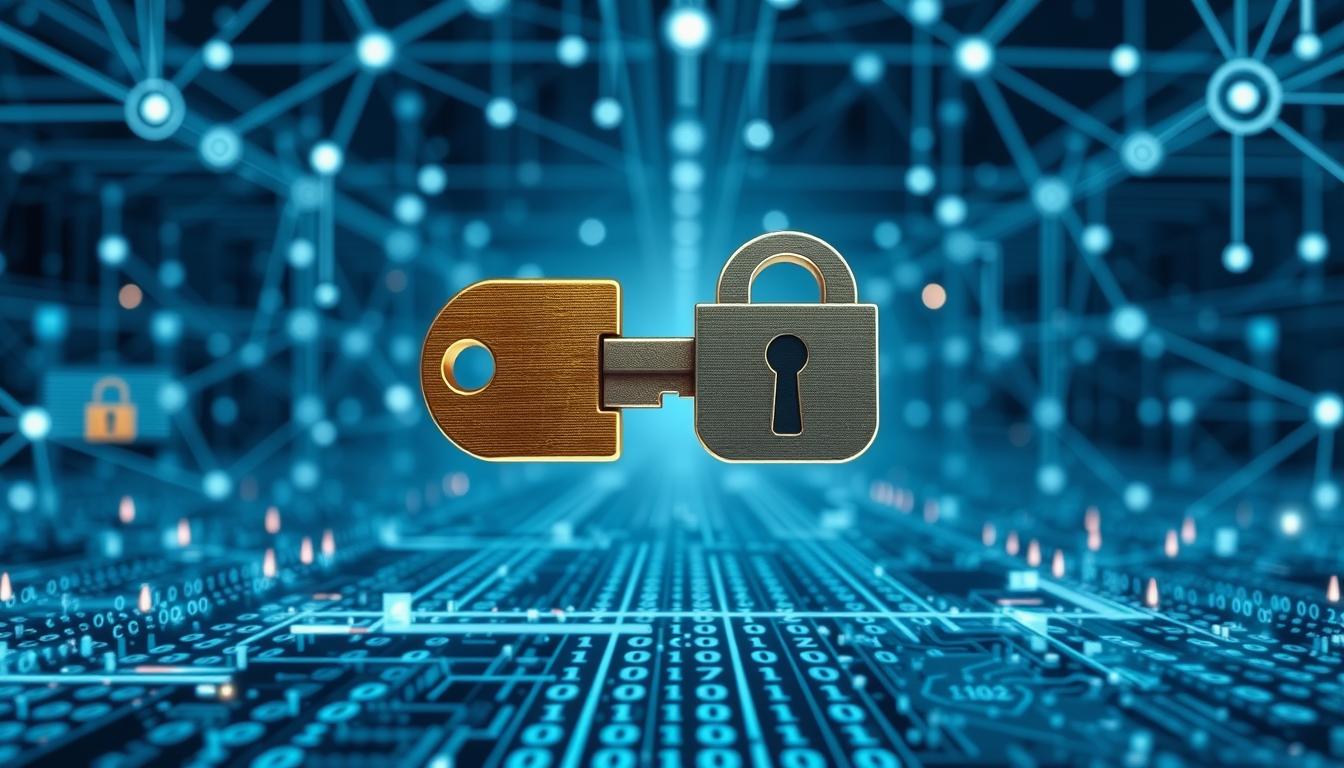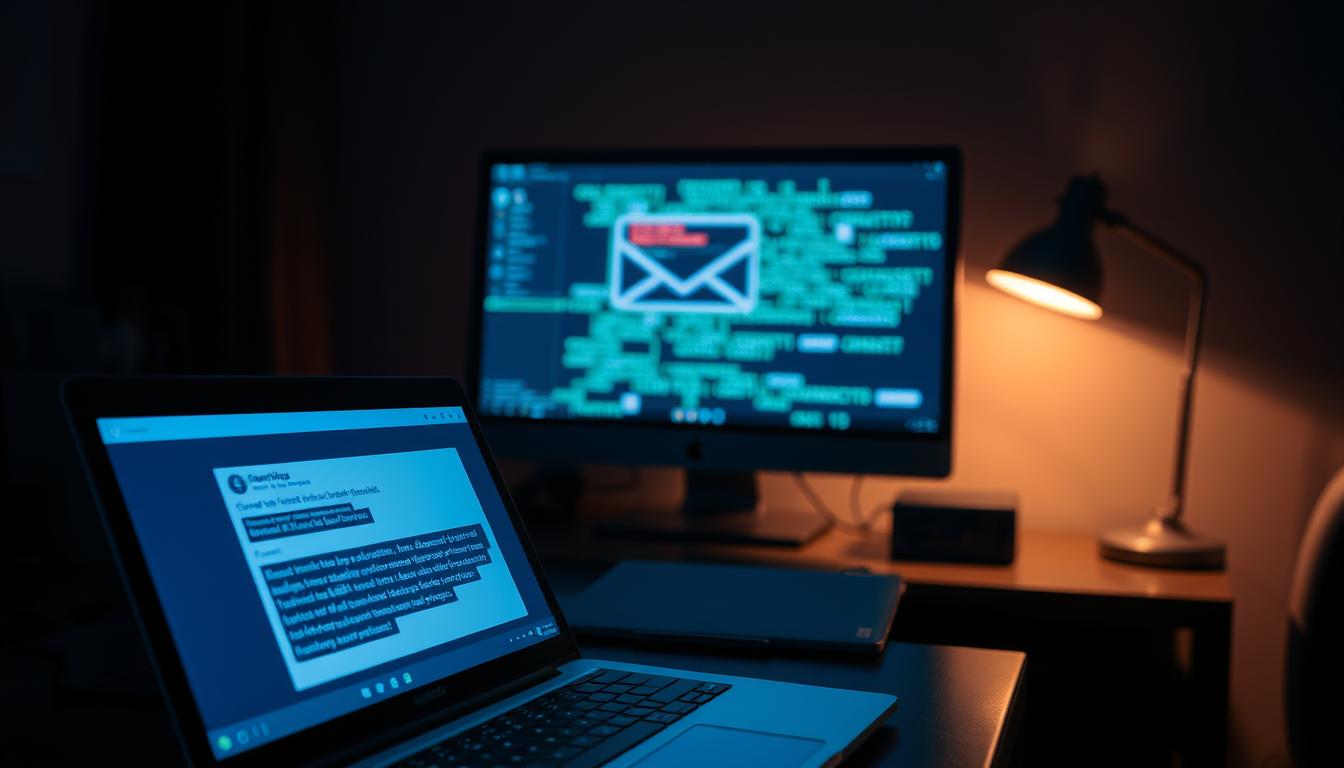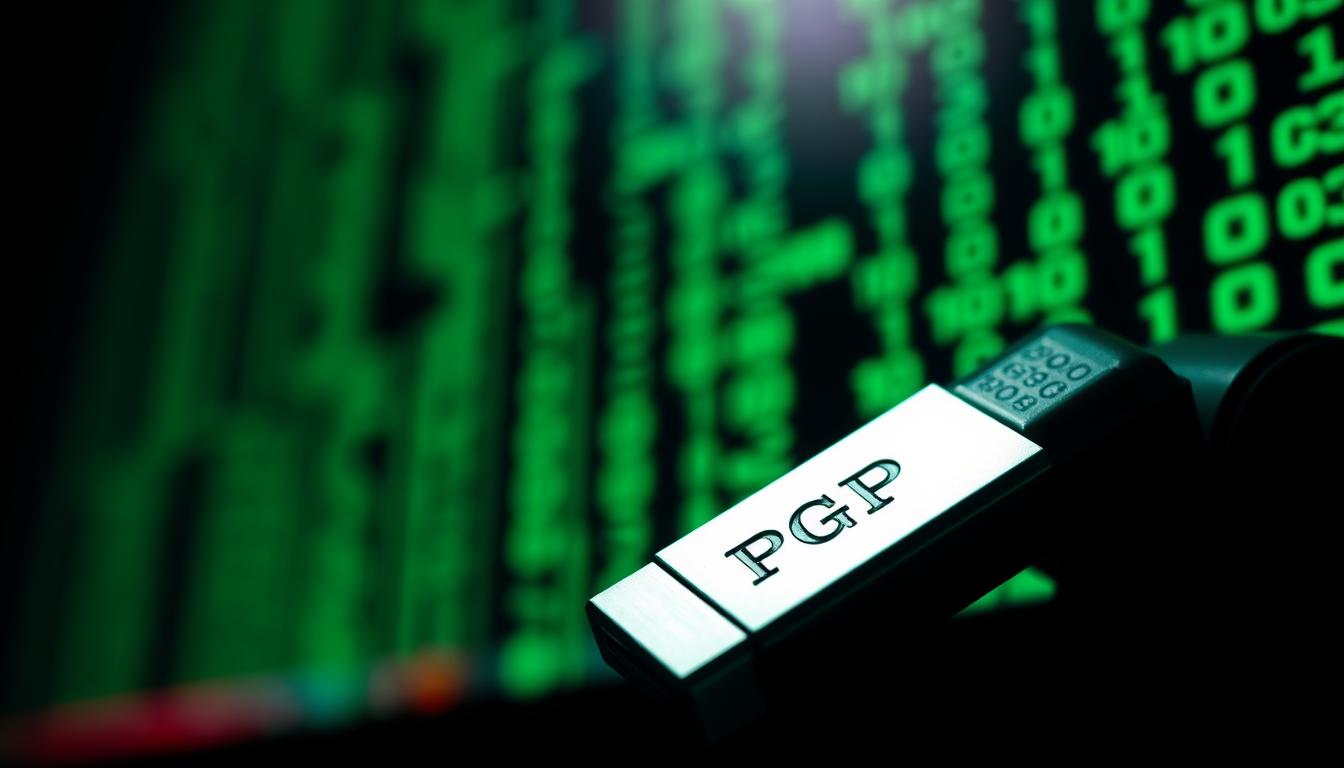In 1991, Phil Zimmermann introduced a groundbreaking method for securing digital communications. This method became a standard for protecting emails and files, blending symmetric and public-key cryptography. Its dual functionality ensures both sender identity verification and message confidentiality.
At its core, this system relies on a pair of keys: a public key for encryption and a private key for decryption. This combination safeguards sensitive data, making it a trusted choice for users worldwide. The process also includes digital signatures, adding an extra layer of security.

Over the years, this approach has proven its effectiveness, even in high-stakes scenarios. Its robust design continues to protect data from unauthorized access, offering peace of mind to individuals and organizations alike.
Key Takeaways
- Developed in 1991, this method revolutionized secure digital communication.
- Uses a blend of symmetric and public-key cryptography for protection.
- Relies on public and private keys to encrypt and decrypt data.
- Includes digital signatures to verify sender identity.
- Trusted for safeguarding sensitive information globally.
Understanding the Basics of PGP Encryption
The need for robust email security sparked the development of a powerful encryption method. In today’s digital landscape, protecting sensitive data is more critical than ever. This is where PGP steps in, offering a reliable solution for secure communication.
Overview and Importance of PGP
Originally released as freeware, PGP quickly gained traction among users seeking enhanced email security. Its accessibility played a key role in its widespread adoption. By combining symmetric and public-key encryption, PGP ensures that messages remain confidential and tamper-proof.
Digital signatures are another cornerstone of PGP. They verify the sender’s identity, adding an extra layer of trust. This dual functionality makes PGP a trusted choice for individuals and organizations alike.
How PGP Combines Symmetric and Public-Key Cryptography
PGP’s hybrid approach leverages the strengths of both symmetric and public-key encryption. Symmetric encryption is fast and efficient, ideal for encrypting large amounts of data. Public-key encryption, on the other hand, provides robust security by using a pair of keys: one public and one private.
- Symmetric encryption ensures speed and efficiency.
- Public-key encryption offers enhanced security for key exchange.
- Digital signatures verify authenticity and prevent tampering.
Understanding these basics empowers users to make informed decisions about their encryption needs. Whether for personal or professional use, PGP remains a trusted tool for safeguarding sensitive information.
What is Pretty Good Privacy PGP encryption: Definition and Key Concepts
The foundation of secure digital communication lies in the effective use of cryptographic systems. This method combines advanced techniques to ensure data remains confidential and tamper-proof. At its core, it relies on a hybrid approach, blending symmetric and public-key cryptography for maximum security.

Public Key vs. Private Key
The encryption process hinges on two critical components: the public key and the private key. The public key is shared openly and used to encrypt messages. The private key, kept secure by the recipient, decrypts the data. This dual-key system ensures only the intended recipient can access the information.
Encryption Algorithms and Digital Signatures
Various algorithms play a vital role in this process. RSA and Diffie-Hellman are two widely used methods for generating secure session keys. These algorithms ensure that data remains protected during transmission.
Digital signatures add another layer of security. They verify the sender’s identity and confirm the message’s integrity. This way, recipients can trust that the content hasn’t been altered.
- RSA: A widely adopted algorithm for secure key exchange.
- Diffie-Hellman: Known for its efficiency in generating session keys.
- Digital Signatures: Essential for verifying authenticity and preventing tampering.
By leveraging these tools, users can ensure their communications remain secure and trustworthy. This system continues to set the standard for protecting sensitive information in the digital age.
How PGP Enhances Email Security
Email remains a primary target for cyber threats, making advanced security measures essential. PGP, or Pretty Good Privacy, provides a reliable solution to safeguard sensitive communications. By encrypting emails and verifying sender identities, it ensures both confidentiality and trust.

Securing Email Communications
PGP employs a hybrid approach to secure emails. It uses symmetric encryption for speed and efficiency, combined with public-key encryption for robust security. Each email is encrypted with a unique session key, preventing reuse and enhancing protection.
For example, ProtonMail integrates PGP automatically, simplifying the process for users. This ensures that even complex cryptographic steps remain hidden, making secure communication accessible to everyone.
Verifying Sender Identity with Digital Signatures
Digital signatures play a crucial role in PGP. They verify the sender’s identity and ensure the message remains untampered. This adds an extra layer of trust, especially in professional or sensitive communications.
Maintaining updated keys and secure practices is vital. Regularly renewing keys and backing them up can significantly reduce the risk of data loss or unauthorized access.
- PGP ensures end-to-end security for email communications.
- Digital signatures verify sender authenticity and message integrity.
- Platforms like ProtonMail simplify PGP integration for users.
- Secure practices, like key updates, enhance overall protection.
Implementing PGP: Tools and Software Options
Modern communication demands robust tools to ensure data remains secure and private. Whether you’re an individual or part of an organization, choosing the right software is essential for maintaining good privacy standards. This section explores the best options available for integrating secure communication into your daily routine.

Email Client Integrations
Popular email clients like Thunderbird, Outlook, and Apple Mail offer seamless integration with secure communication tools. For Thunderbird, Enigmail is a trusted plugin that simplifies the process. Outlook users can rely on Gpg4o, while GPGTools provides a smooth experience for Apple Mail.
These tools ensure that sensitive information remains protected. They also support digital signatures, verifying the sender’s identity and enhancing trust between the sender and recipient.
Web-Based Solutions and Mobile Compatibility
Web-based platforms like ProtonMail make secure communication accessible to everyone. They handle encryption automatically, reducing the complexity for users. ProtonMail also supports mobile apps, ensuring you can protect your data on the go.
Mobile applications like FairEmail bring secure communication to smartphones. These apps are designed with user-friendliness in mind, making it easy for any person to adopt secure practices.
- Thunderbird: Enigmail plugin for easy integration.
- Outlook: Gpg4o for robust security.
- Apple Mail: GPGTools for seamless encryption.
- ProtonMail: Web-based and mobile-friendly.
- FairEmail: Mobile app for on-the-go security.
Selecting the right tool depends on your specific needs. Consider factors like platform compatibility, ease of use, and the level of security required. By choosing wisely, you can ensure your communications remain private and secure.
Step-by-Step Guide to Setting Up PGP Encryption
Setting up secure communication tools can seem daunting, but with the right steps, it becomes straightforward. Whether you’re an individual or part of a company, following a structured process ensures your data remains protected. This guide walks you through downloading, installing, and configuring key management for reliable security.

Downloading and Installing the Software
The first step involves selecting the right software for your needs. For Thunderbird users, Enigmail is a popular choice. Apple Mail users can opt for GPGTools. Both tools simplify the setup process and integrate seamlessly with your email client.
To install Enigmail, open Thunderbird and navigate to the add-ons section. Search for Enigmail and click install. For GPGTools, visit the official website, download the installer, and follow the on-screen instructions. Ensure you verify the software’s authenticity to avoid compromised versions.
Configuring Key Management and Certificate Setup
Once the software is installed, the next step is generating your key pair. Open the software and select the option to create a new key. Enter your name, email address, and a strong passphrase. This form of protection ensures only you can access your private key.
After generating the keys, upload your public key to a key server. This allows others to encrypt messages for you. For example, with GPGTools, you can export your public key in ASCII form and share it securely. Always back up your private key and store it in a safe location.
| Tool | Installation Steps | Key Management Features |
| Enigmail (Thunderbird) | Add-on installation via Thunderbird | Key generation, public key sharing |
| GPGTools (Apple Mail) | Download and run installer | Key export, key server integration |
Common challenges include forgetting passphrases or losing access to private keys. To mitigate these risks, create a revocation certificate during the setup process. This ensures you can disable your keys if they are compromised.
For companies, coordinating the setup across multiple users is essential. Establish clear guidelines for key management and ensure all team members follow secure procedures. Regularly update keys and review security practices to maintain data integrity.
By following these steps, you can set up secure communication tools effectively. Whether you’re an individual or part of a company, this process ensures your data remains protected from unauthorized access.
PGP for File Encryption and Data Protection
Protecting sensitive files is a critical aspect of modern data security, and PGP offers a robust solution. Beyond emails, this method is widely used to secure files on devices and in cloud storage. Its versatility makes it a trusted choice for individuals and organizations alike.

Encrypting Files on Your Devices and Cloud
Using PGP for file encryption ensures data remains confidential, whether stored locally or in the cloud. The process involves generating a unique key pair for each file, safeguarding it from unauthorized access. This approach is particularly effective for sensitive documents, financial records, and intellectual property.
The OpenPGP standard plays a key role in this process. It supports multiple implementations, ensuring interoperability across different encryption software. This standardization simplifies integration and enhances compatibility, making it easier to adopt secure practices.
Several products leverage PGP for file security. Symantec Encryption Desktop is a popular commercial option, offering advanced features for enterprise use. Open-source alternatives like GnuPG provide flexibility and cost-effectiveness for individual users. Both options ensure data remains protected, regardless of the platform.
| Product | Type | Key Features |
| Symantec Encryption Desktop | Commercial | Advanced encryption, enterprise support |
| GnuPG | Open-source | Flexible, cost-effective |
Industries such as healthcare, finance, and legal services rely on PGP for file encryption. For example, medical records and legal documents often require high levels of security. PGP ensures compliance with regulations like HIPAA and GDPR, protecting sensitive information from breaches.
Best practices for file encryption include routine updates and secure key management. Regularly renewing keys and backing them up reduces the risk of data loss. Additionally, choosing the right software based on specific needs ensures optimal protection.
Technical considerations when implementing PGP include compatibility with existing systems and ease of use. Selecting software that integrates seamlessly with your workflow enhances efficiency. Training employees on secure practices further strengthens overall data security.
By adopting PGP for file encryption, users can safeguard their data effectively. Whether for personal or professional use, this method provides a reliable solution for maintaining confidentiality and trust.
Overcoming Challenges and Drawbacks with PGP
Balancing security and usability is a common challenge in digital communication. While PGP offers robust protection, its complexity can deter users. Understanding these hurdles and addressing them effectively ensures a smoother implementation process.

Addressing Usability and Learning Curve
One of the main drawbacks of PGP is its steep learning curve. New users often struggle with setup and daily operation. The non-intuitive interface can lead to misconfigurations, reducing the effectiveness of encrypted messages.
To overcome this, consider using user-friendly tools like ProtonMail or Thunderbird with Enigmail. These platforms simplify the process, making secure communication accessible. Regular training sessions can also help users navigate the system confidently.
Maintaining Security Without Compromising Convenience
Security should never come at the cost of convenience. Proper server configuration is essential to ensure PGP continues to work as intended. Regular updates and key renewals prevent vulnerabilities and maintain system integrity.
For companies, integrating PGP with broader cybersecurity strategies enhances protection. Tools like Symantec Encryption Desktop offer advanced features for enterprise use. Open-source alternatives like GnuPG provide flexibility for individual users.
- Simplify setup with user-friendly tools like ProtonMail or Thunderbird.
- Ensure proper server configuration for optimal performance.
- Regularly update keys and software to prevent vulnerabilities.
- Compare PGP with alternatives to understand its strengths and limitations.
- Provide training to users for confident and secure implementation.
By addressing these challenges, users can leverage PGP’s robust security without sacrificing usability. Whether for personal or professional use, these strategies ensure encrypted messages remain protected and accessible.
Best Practices for Maintaining PGP Encryption Security
Maintaining robust security in digital communication requires consistent effort and best practices. Regular updates, key renewals, and strategic integration with broader cybersecurity measures are essential. These steps ensure that encrypted data remains secure and accessible over time.

Regular Updating and Key Renewals
One of the most critical practices is keeping encryption tools and keys up to date. Regular updates prevent vulnerabilities and ensure compatibility with the latest security standards. Key renewal policies, such as setting expiration dates every two years, enhance protection.
Performing routine decryption tests is equally important. These tests verify that keys and encrypted messages remain functional. They also help identify potential issues before they compromise data security.
- Set key expiration dates to encourage regular renewals.
- Generate revocation certificates for compromised keys.
- Conduct decryption tests to ensure accessibility.
Integrating PGP with Broader Cybersecurity Strategies
PGP should be part of a comprehensive cybersecurity service framework. Integrating it with threat detection tools and secure platforms enhances overall protection. This approach ensures that encrypted data aligns with broader security goals.
Clear identity verification processes are vital when sharing encrypted information. Digital signatures and secure key exchanges build trust between parties. They also prevent unauthorized access to sensitive data.
For organizations, training employees on secure practices is essential. Regular updates and secure key management reduce the risk of breaches. Combining PGP with other security measures creates a robust defense against cyber threats.
Conclusion
From its inception, this approach has set the standard for protecting sensitive information. Over the years, it has evolved from freeware to a widely adopted method, ensuring secure communication across industries. By combining email and file encryption, it offers a robust framework for safeguarding data.
Balancing security and usability remains a key challenge. While the method provides strong protection, its complexity requires proper training and implementation. Tools like ProtonMail and Symantec Encryption Desktop simplify the process, making it accessible to users and organizations alike.
The evolution of this approach highlights its enduring relevance. It continues to address modern cybersecurity needs, from personal communication to enterprise-level protection. By adopting best practices like regular key updates and secure configurations, users can maximize its benefits.
For those seeking to enhance their digital security, exploring this method is a valuable step. Its proven track record and adaptability make it a trusted choice in today’s cyber landscape. Take action now to integrate this reliable solution into your daily security protocols.